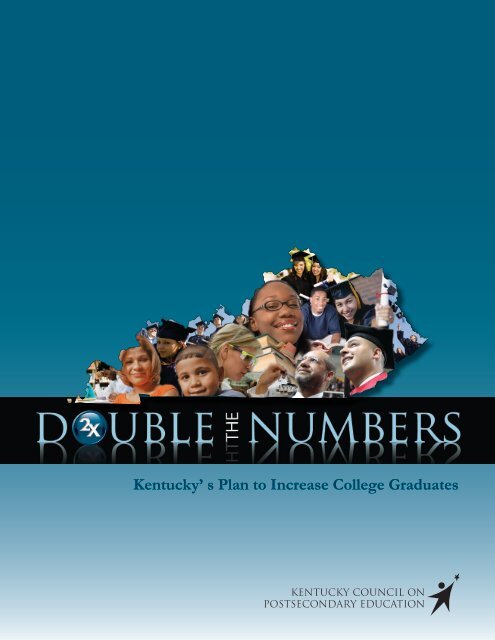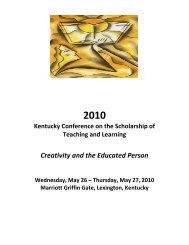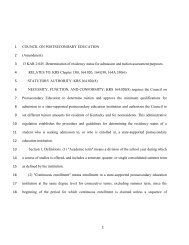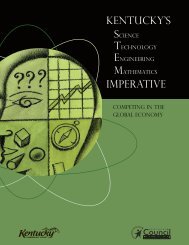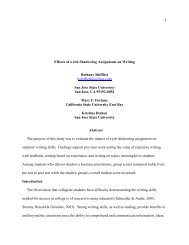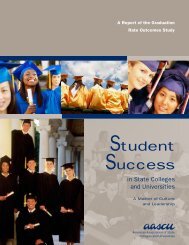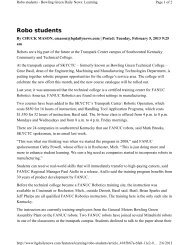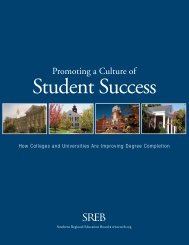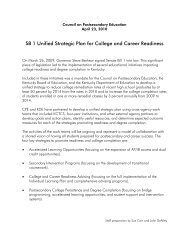Double the Numbers: Kentucky's Plan to Increase College Graduates
Double the Numbers: Kentucky's Plan to Increase College Graduates
Double the Numbers: Kentucky's Plan to Increase College Graduates
Create successful ePaper yourself
Turn your PDF publications into a flip-book with our unique Google optimized e-Paper software.
Kentucky’ s <strong>Plan</strong> <strong>to</strong> <strong>Increase</strong> <strong>College</strong> <strong>Graduates</strong><br />
KENTUCKY COUNCIL ON<br />
POSTSECONDARY EDUCATION
Kentucky Council on Postsecondary Education<br />
1024 Capital Center Drive, Suite 320<br />
Frankfort, KY 40601<br />
Ph: (502) 573-1555<br />
Fax: (502) 573-1535<br />
http://cpe.ky.gov<br />
The Kentucky Council on Postsecondary Education does not discriminate on <strong>the</strong> basis of<br />
race, color, national origin, sex, religion, age, or disability in employment or <strong>the</strong> provision of<br />
services and provides, upon request, reasonable accommodation including auxiliary aids and<br />
services necessary <strong>to</strong> afford individuals with disabilities an equal opportunity <strong>to</strong> participate in<br />
all programs and activities.<br />
Printed with state funds<br />
Oc<strong>to</strong>ber 2007
DOUBLE THE NUMBERS<br />
Kentucky’s <strong>Plan</strong> <strong>to</strong> <strong>Increase</strong> <strong>College</strong> <strong>Graduates</strong><br />
OCTOBER 2007
To raise Kentucky’s standard of living <strong>to</strong> <strong>the</strong><br />
national average by 2020, we must<br />
<strong>Double</strong> <strong>the</strong> Number<br />
of college graduates living in Kentucky.<br />
We are in <strong>the</strong> middle of <strong>the</strong> most dramatic economic and social<br />
transformation in Kentucky’s his<strong>to</strong>ry.<br />
In 1997, <strong>the</strong> General Assembly passed <strong>the</strong> Kentucky Postsecondary<br />
Education Improvement Act (House Bill 1). The law states that in order <strong>to</strong><br />
raise our standard of living and quality of life <strong>to</strong> <strong>the</strong> national average by <strong>the</strong><br />
year 2020, we must increase our educational attainment. Reaching this goal<br />
requires that we <strong>Double</strong> <strong>the</strong> <strong>Numbers</strong>—double <strong>the</strong> number of Kentuckians<br />
empowered by a bachelor’s degree.<br />
Now, with only 13 years <strong>to</strong> go, we must renew our commitments and plot<br />
carefully <strong>the</strong> path that will lead us <strong>to</strong> <strong>the</strong> goal.<br />
We are making progress, but not fast enough.<br />
Since 2000, we have increased <strong>the</strong> annual number of degrees and<br />
credentials 62 percent. 1 And this has contributed <strong>to</strong> a remarkable increase—<br />
22 percent—in our per capita income. 2<br />
But we are not gaining ground fast enough. A recent Kentucky Science<br />
and Technology Corporation report determined that if we don’t intensify our<br />
efforts, Kentucky won’t reach <strong>the</strong> national average in per capita income for<br />
ano<strong>the</strong>r 154 years. 3<br />
How will we get <strong>the</strong>re faster? As this chart shows, <strong>the</strong> quickest way <strong>to</strong><br />
increase our per capita income is <strong>to</strong> raise <strong>the</strong> percent of Kentuckians with a<br />
bachelor’s degree.<br />
Per Capita Income<br />
32,000 -<br />
30,000 -<br />
28,000 -<br />
26,000 -<br />
24,000 -<br />
22,000 -<br />
20,000 -<br />
18,000 -<br />
Figure 1: The relationship between<br />
per capita income and college degrees<br />
WV<br />
KY<br />
NV<br />
<br />
AR<br />
<br />
MS<br />
MI FL<br />
<br />
WI PA GA<br />
WY <br />
OR<br />
OH MO<br />
IN<br />
<br />
<br />
ME<br />
IA AZ<br />
<br />
<br />
NE<br />
TX<br />
TN SC <br />
NC ND<br />
SD<br />
AL MT<br />
<br />
<br />
<br />
ID UT<br />
OK <br />
LA NM<br />
NH VA<br />
<br />
NY<br />
DE MN<br />
<br />
<br />
IL RI<br />
AK<br />
<br />
WA<br />
<br />
CA<br />
HI<br />
<br />
KS<br />
MD<br />
NJ MA <br />
VT<br />
<br />
CT<br />
<br />
CO<br />
<br />
“The single fac<strong>to</strong>r with <strong>the</strong><br />
greatest power <strong>to</strong> explain<br />
<strong>the</strong> difference in per capita<br />
income is <strong>the</strong> percent of<br />
college graduates.”<br />
-The Milken Institute<br />
16,000 - <br />
15%<br />
<br />
20%<br />
<br />
25%<br />
<br />
30%<br />
Population with a Bachelor’s Degree or Higher<br />
<br />
35%<br />
<br />
40%<br />
Source: U.S. Census Bureau, American Community Survey 2003<br />
kentucky Council on Postsecondary Education<br />
5
Civic participation and earnings data show<br />
why it is so important<br />
that we <strong>Double</strong> <strong>the</strong> <strong>Numbers</strong>.<br />
There is a strong correlation between education level and personal income,<br />
productivity, civic participation, life expectancy, employment status, and<br />
community strength.<br />
<strong>College</strong> graduates earn more.<br />
• Kentuckians with bachelor’s degrees typically earn over $16,000<br />
more a year than high school graduates.<br />
• The average U.S. bachelor’s degree recipient can expect <strong>to</strong> earn<br />
62 percent more over a 40-year working life than <strong>the</strong> average high<br />
school graduate. 4<br />
Figure 2: Median annual earnings of Kentuckians by degree, 2006<br />
Graduate/prof.<br />
degree<br />
Bachelor’s<br />
degree<br />
$40,603<br />
$46,785<br />
Some college/<br />
assoc. degree<br />
H.S. diploma<br />
Less than<br />
H.S. diploma<br />
$17,523<br />
$24,344<br />
$29,081<br />
Source: 2007 Education Pays Update, <strong>College</strong> Board<br />
<strong>College</strong> graduates tend <strong>to</strong> be more engaged citizens.<br />
<strong>College</strong> graduates are<br />
healthier: <strong>the</strong>y are more<br />
likely <strong>to</strong> exercise, less<br />
likely <strong>to</strong> smoke, and<br />
more likely <strong>to</strong> have<br />
health insurance.<br />
-Education Pays 2007<br />
<strong>College</strong> Board<br />
• In 2006, about 27 percent of U.S. adults volunteered for community<br />
organizations. Among college graduates, <strong>the</strong> volunteer rate was 43<br />
percent, over twice <strong>the</strong> 19 percent rate for high school graduates.<br />
• In <strong>the</strong> 2004 presidential election, 76 percent of U.S. college<br />
graduates reported voting, compared <strong>to</strong> 49 percent of high school<br />
graduates. 5<br />
Figure 3: Percent of U.S. adults who volunteer by degree, 2007<br />
Bachelor’s<br />
degree<br />
Some college/<br />
assoc. degree<br />
31%<br />
43%<br />
H.S. diploma<br />
19%<br />
Less than<br />
H.S. diploma<br />
9%<br />
Source: 2007 Education Pays Update, <strong>College</strong> Board<br />
6<br />
kentucky Council on Postsecondary Education
States with more college graduates generally enjoy a higher<br />
quality of life.<br />
• Incarceration rates for U.S. adults with some postsecondary<br />
education are about a quarter of that for individuals with only a<br />
high school diploma. 6<br />
• Government spending for public assistance programs tends <strong>to</strong><br />
decrease as levels of education increase. 7<br />
• Kentuckians with higher education levels have lower rates of<br />
poverty.<br />
Figure 4: Percent of Kentuckians in poverty by degree, 2006<br />
31%<br />
3%<br />
Graduate/prof.<br />
degree<br />
4%<br />
Bachelor’s<br />
degree<br />
States with more college graduates have stronger, more<br />
diverse economies.<br />
9%<br />
Some college/<br />
assoc. degree<br />
14%<br />
• Unemployment rates are much lower for college graduates than<br />
for high school graduates. 8<br />
• The <strong>to</strong>p states in educational attainment also rank highest<br />
on <strong>the</strong> New Economy Index, which measures innovation,<br />
entrepreneurship, and competitiveness in <strong>the</strong> global economy.<br />
Kentucky ranks 45th on this index. 9<br />
The Kentucky Long-Term Policy Research Center has estimated<br />
that doubling <strong>the</strong> number of bachelor’s degree holders by 2020<br />
could produce an additional $139.5 billion in <strong>the</strong> personal income of<br />
Kentuckians and add $9 billion in tax revenue <strong>to</strong> <strong>the</strong> General Fund. 10<br />
H.S. diploma<br />
Source: U.S. Census Bureau, 2006 American Community Survey<br />
Less than<br />
H.S. diploma<br />
“By investing in its<br />
workforce and achieving<br />
<strong>the</strong> national rate of<br />
working-age adults with a<br />
bachelor’s degree or higher<br />
by 2020, Kentucky<br />
stands <strong>to</strong> gain billions of<br />
dollars in personal<br />
income and revenue over<br />
what it will achieve at<br />
current producation levels.”<br />
-Kentucky Long-Term Policy<br />
Research Center<br />
kentucky Council on Postsecondary Education<br />
7
While o<strong>the</strong>r goals are important,<br />
bachelor’s degrees<br />
are <strong>the</strong> quickest, most direct link <strong>to</strong> economic prosperity.<br />
Kentucky’s <strong>Double</strong> <strong>the</strong> <strong>Numbers</strong> <strong>Plan</strong> does not diminish <strong>the</strong> importance<br />
of associate or advanced degrees, which are vital <strong>to</strong> our state’s economy.<br />
The o<strong>the</strong>r goals of House Bill 1—like increased research and development,<br />
greater regional stewardship, and improved adult education and training—<br />
will continue <strong>to</strong> be pursued.<br />
But <strong>the</strong> <strong>Plan</strong> focuses on bachelor’s degree production because:<br />
• The link between economic prosperity and educational attainment<br />
is most dramatic at <strong>the</strong> bachelor’s degree level, both for states and<br />
for individuals.<br />
• At <strong>the</strong> current rate of improvement, Kentucky is on track <strong>to</strong> meet or<br />
exceed <strong>the</strong> national average in associate degree production, but<br />
will fall far short in bachelor’s degrees.<br />
• Master’s and advanced degrees, while vital <strong>to</strong> <strong>the</strong> new economy,<br />
cannot be obtained without a bachelor’s degree.<br />
Simply put, this plan is <strong>the</strong> most substantial contribution our postsecondary<br />
education programs can make <strong>to</strong> Kentucky’s quality of life in <strong>the</strong> shortest<br />
period of time.<br />
35%<br />
Figure 5: Percent of population with a college degree<br />
32%<br />
Demographers predict that<br />
in 2020, about 1 of every<br />
3 Americans will have a<br />
bachelor’s degree. In 2000,<br />
about 1 in 5 Kentuckians<br />
had a bachelor’s degree. If<br />
current trends continue, we<br />
will fall short of our goal<br />
by about 211,000 college<br />
graduates.<br />
30%<br />
25%<br />
20%<br />
15%<br />
19%<br />
<strong>Double</strong> <strong>the</strong> <strong>Numbers</strong><br />
Current Trend<br />
2000 2020<br />
24%<br />
8<br />
kentucky Council on Postsecondary Education
The <strong>Double</strong> <strong>the</strong> <strong>Numbers</strong> <strong>Plan</strong> clearly outlines<br />
what it will take<br />
for Kentucky <strong>to</strong> reach educational parity with<br />
<strong>the</strong> rest of <strong>the</strong> nation.<br />
To quantify <strong>the</strong> bachelor’s degree challenge, <strong>the</strong> Council posed <strong>the</strong> following<br />
questions.<br />
1.<br />
2.<br />
3.<br />
What will <strong>the</strong> national level of bachelor’s degree attainment be in<br />
2020?<br />
Where will Kentucky be in 2020 if <strong>the</strong> system continues <strong>to</strong> produce<br />
bachelor’s degrees at <strong>the</strong> current rate?<br />
Will <strong>the</strong>re be a gap and, if so, what will that gap be?<br />
To answer <strong>the</strong> first question, we selected a methodology advanced by a<br />
2000 U.S. Census Working Paper. 11 Because it projects <strong>the</strong> rate <strong>to</strong> 2028<br />
and draws on 15 years of best-available data, this methodology offers <strong>the</strong><br />
most sophisticated projection with <strong>the</strong> lowest probable degree of error. The<br />
final analysis produced an estimate of 32 percent, meaning that by <strong>the</strong> year<br />
2020, 32 percent of all working-age Americans (25-64) will have at least a<br />
bachelor’s degree or higher.<br />
Next, we examined <strong>the</strong> Kentucky State Data Center’s working-age population<br />
projection for 2020, which is just shy of 2.5 million. Applying <strong>the</strong> national rate<br />
of 32 percent <strong>to</strong> this number yields 791,000 Kentuckians.<br />
Finally, assuming <strong>the</strong> system continues <strong>to</strong> perform at <strong>the</strong> current degree<br />
production rate, we calculated that 580,000 bachelor’s degree holders will be<br />
produced by 2020. This number was derived as follows:<br />
• Start with <strong>the</strong> 402,000 working-age bachelor’s degree holders living<br />
in Kentucky in 2000.<br />
• Subtract <strong>the</strong> 167,000 who were 45-65 years old in 2000, who will<br />
age out of <strong>the</strong> working-age population by 2020.<br />
• Add 14,000 for predicted net migration from 2000 <strong>to</strong> 2020.<br />
• Add 65,000 for <strong>the</strong> bachelor’s degrees produced from 2000 <strong>to</strong> 2004.<br />
• Add 266,000 for <strong>the</strong> bachelor’s degrees that will be produced<br />
from 2005 <strong>to</strong> 2020.<br />
The resulting 580,000 represents about 24 percent of <strong>the</strong> projected workingage<br />
population, which is well below <strong>the</strong> predicted national average<br />
of 32 percent.<br />
“Thirty years ago, <strong>the</strong><br />
United States could lay<br />
claim <strong>to</strong> having 30 percent<br />
of <strong>the</strong> world’s population<br />
of college students. Today<br />
that proportion has fallen<br />
<strong>to</strong> 14 percent and is<br />
continuing <strong>to</strong> fall.”<br />
-New Commission on <strong>the</strong><br />
Skills of <strong>the</strong> American Workforce<br />
kentucky Council on Postsecondary Education<br />
9
To achieve <strong>the</strong> <strong>Double</strong> <strong>the</strong> <strong>Numbers</strong> goal<br />
five essential strategies<br />
must be vigorously and urgently advanced.<br />
With help from <strong>the</strong> National Center for Higher Education Management<br />
Systems and Kentucky’s nine public postsecondary institutions, <strong>the</strong> Council<br />
has outlined five strategies which, if implemented concurrently over <strong>the</strong> next<br />
13 years, will produce <strong>the</strong> additional degree holders needed <strong>to</strong><br />
<strong>Double</strong> <strong>the</strong> <strong>Numbers</strong>.<br />
The five strategies target <strong>the</strong> following groups of Kentuckians:<br />
•<br />
•<br />
•<br />
The thousands of young Kentuckians who enter <strong>the</strong> ninth grade each<br />
year but never graduate from high school.<br />
The thousands of Kentuckians—about 1 of every 5—who lack a high<br />
school diploma or GED.<br />
The one million working-age adults without a bachelor’s degree.<br />
To attract and retain college graduates, Kentucky also must recruit and<br />
develop new businesses with jobs that require college degrees.<br />
STRATEGY<br />
1<br />
Raise high school<br />
graduation rates.<br />
In 2006, <strong>the</strong>re were 58,000 ninth-graders in <strong>the</strong> state but only 40,000<br />
seniors. 12 Kentucky must increase <strong>the</strong> number of high school graduates <strong>to</strong><br />
48,000 in 2020.<br />
Statewide tactics<br />
• Expanded opportunities for students <strong>to</strong> earn college credit during<br />
high school and lessen time-<strong>to</strong>-degree.<br />
• More intervention programs for middle and high school students <strong>to</strong><br />
identify and remedy gaps in <strong>the</strong>ir preparation for college.<br />
• A redesigned Web site (www.GoHigherKY.org) where Kentuckians<br />
can efficiently plan for college and complete admission and<br />
financial aid applications online.<br />
2020 statewide targets<br />
• <strong>Increase</strong> <strong>the</strong> number of high school graduates from 40,000 <strong>to</strong><br />
48,000.<br />
• Raise <strong>the</strong> percent of high school freshmen who graduate four years<br />
later from 72 percent <strong>to</strong> 81 percent.<br />
10<br />
kentucky Council on Postsecondary Education
STRATEGY<br />
2<br />
<strong>Increase</strong> <strong>the</strong> number of GED graduates<br />
and transition more <strong>to</strong> college.<br />
A full 60 percent of adult Kentuckians have no education beyond high school;<br />
26 percent have less than a high school diploma. As <strong>the</strong> baby boomers<br />
mature, Kentucky is becoming an aging state—<strong>the</strong>re are not enough young<br />
people coming up through <strong>the</strong> pipeline <strong>to</strong> replace <strong>the</strong> current workforce by <strong>the</strong><br />
year 2020. Our demographic reality is that no one is expendable. Kentucky<br />
must reach out <strong>to</strong> <strong>the</strong> nearly 800,000 adults with low educational skills, help<br />
<strong>the</strong>m earn a GED, and <strong>the</strong>n transition <strong>the</strong>m <strong>to</strong> college.<br />
Statewide tactics<br />
• Higher academic standards so graduates are better prepared for<br />
college and high-quality employment.<br />
• Enhanced teacher standards and professional development <strong>to</strong><br />
streng<strong>the</strong>n <strong>the</strong> skills and abilities of <strong>the</strong> teaching force.<br />
• New incentives for adults <strong>to</strong> complete <strong>the</strong> GED and transition <strong>to</strong><br />
postsecondary education.<br />
2020 statewide targets<br />
• Raise <strong>the</strong> annual number of GED graduates from 9,800<br />
<strong>to</strong> 15,000.<br />
• <strong>Increase</strong> <strong>the</strong> college-going rate of GED graduates from<br />
19 percent <strong>to</strong> 36 percent.<br />
“Adult literacy is a<br />
fundamental barrier <strong>to</strong><br />
every major challenge<br />
facing Kentucky including<br />
early childhood education,<br />
education reform, economic<br />
development, and improving<br />
<strong>the</strong> health and well-being<br />
of Kentucky’s families and<br />
communities.”<br />
-Senate Bill 1<br />
The Adult Education Act of 2000<br />
kentucky Council on Postsecondary Education<br />
11
STRATEGY<br />
3<br />
Enroll more first-time students in KCTCS<br />
and transfer <strong>the</strong>m <strong>to</strong> 4-year programs.<br />
Without <strong>the</strong> Kentucky Community and Technical <strong>College</strong> System, Kentucky’s<br />
four-year universities do not have <strong>the</strong> capacity <strong>to</strong> serve <strong>the</strong> additional students<br />
needed <strong>to</strong> <strong>Double</strong> <strong>the</strong> <strong>Numbers</strong>. Encouraging more students <strong>to</strong> begin <strong>the</strong>ir<br />
college careers at KCTCS saves money for <strong>the</strong> system and <strong>the</strong> students.<br />
The success of this strategy depends on getting more students <strong>to</strong> take <strong>the</strong>ir<br />
general education required courses at a community or technical college, <strong>the</strong>n<br />
transfer <strong>the</strong>se credits <strong>to</strong> a four-year degree program. We also must ensure<br />
community and technical college tuition is affordable for every Kentuckian.<br />
Statewide tactics<br />
• Expanded capability at community and technical colleges <strong>to</strong> deliver a<br />
general education component.<br />
• Enhanced partnerships <strong>to</strong> provide collaborative advising and student<br />
services <strong>to</strong> support transfer.<br />
• <strong>Increase</strong>d affordability at community and technical colleges and more<br />
financial aid opportunities for adult part-time and transfer students.<br />
2020 statewide targets<br />
“Today’s demanding and<br />
fast-paced environment<br />
is changing <strong>the</strong> patterns<br />
of attendance in higher<br />
education. More than half<br />
(60 percent) of all first-year<br />
undergraduate students<br />
start <strong>the</strong>ir college education<br />
at two-year community or<br />
for-profit colleges.”<br />
• <strong>Increase</strong> KCTCS enrollment from 86,500 <strong>to</strong> 115,800.<br />
• <strong>Increase</strong> KCTCS transfers <strong>to</strong> four-year universities<br />
from 4,500 <strong>to</strong> 11,300.<br />
-National Articulation and<br />
Transfer Network<br />
12<br />
kentucky Council on Postsecondary Education
STRATEGY<br />
4<br />
<strong>Increase</strong> <strong>the</strong> number of Kentuckians<br />
going <strong>to</strong> and completing college.<br />
Too many Kentuckians do not understand <strong>the</strong> benefits of a bachelor’s degree,<br />
especially in counties where professional job opportunities are scarce. To<br />
compete in <strong>the</strong> knowledge economy, Kentucky must create a college-going<br />
culture where everyone is expected <strong>to</strong> complete some postsecondary<br />
education or training. To succeed, we need an infusion of high school<br />
graduates and working-age adults in<strong>to</strong> our colleges and universities. Once<br />
enrolled, we must help more students complete <strong>the</strong>ir degree by addressing<br />
<strong>the</strong>ir academic, financial, and personal needs early and often.<br />
Statewide tactics<br />
• Incentives and rewards for colleges and universities for increased<br />
degree production.<br />
• Concentrated efforts across <strong>the</strong> system <strong>to</strong> streng<strong>the</strong>n guidance and<br />
support for students at every stage of <strong>the</strong>ir academic careers.<br />
• Expanded capacity <strong>to</strong> serve more students, especially adult learners,<br />
through course redesign, alternative methods of program delivery,<br />
and better coordination of distance education.<br />
• A coordinated statewide outreach initiative <strong>to</strong> communicate <strong>the</strong><br />
importance of earning a bachelor’s degree.<br />
• Redesigned and expanded financial aid programs <strong>to</strong> ensure that<br />
college is possible for all Kentuckians.<br />
2020 statewide targets<br />
• <strong>Increase</strong> <strong>the</strong> percent of high school graduates going directly <strong>to</strong><br />
college from 62 percent <strong>to</strong> 74 percent.<br />
• <strong>Increase</strong> <strong>the</strong> percent of adults in college from 3.6 percent <strong>to</strong><br />
4.5 percent.<br />
• Raise <strong>the</strong> six-year college graduation rate from 45 percent<br />
<strong>to</strong> 56 percent.<br />
• Raise annual bachelor’s degrees awarded from<br />
18,200 <strong>to</strong> 33,700.<br />
kentucky Council on Postsecondary Education<br />
13
STRATEGY<br />
5<br />
Attract college-educated workers <strong>to</strong> <strong>the</strong><br />
state and create new jobs for <strong>the</strong>m.<br />
Even if we succeed in <strong>the</strong> first four strategies, we still will fall short of <strong>the</strong><br />
goal. We must recruit more college-educated workers <strong>to</strong> Kentucky. The<br />
final strategy demands increased job creation—not only in <strong>the</strong> agricultural,<br />
manufacturing, and mining sec<strong>to</strong>rs, but in high-tech, high-wage fields.<br />
Statewide tactics<br />
• Greater efforts <strong>to</strong> attract more research dollars <strong>to</strong> Kentucky and<br />
assist entrepreneurs in commercializing research.<br />
• Intensified efforts <strong>to</strong> greatly expand <strong>the</strong> number of graduates in<br />
science, technology, engineering, and ma<strong>the</strong>matics (STEM) fields.<br />
• Stronger relationships with economic development partners <strong>to</strong><br />
recruit new economy jobs <strong>to</strong> Kentucky.<br />
2020 statewide targets<br />
• Attract 80,000 college-educated adults from outside <strong>the</strong> state<br />
<strong>to</strong> Kentucky through increased job creation and economic<br />
development opportunities.<br />
“Through teaching and<br />
research, America’s colleges<br />
and universities produce<br />
new ideas, new discoveries,<br />
and a richer civic and<br />
cultural life. We depend on<br />
[<strong>the</strong>m] for innovations in<br />
medicine, business, science,<br />
technology, national security,<br />
environmental quality, and<br />
many o<strong>the</strong>r fields.”<br />
–Solutions for Our Future<br />
American Council on Education<br />
14<br />
kentucky Council on Postsecondary Education
BY REGION<br />
Doubling <strong>the</strong> <strong>Numbers</strong> by 2020 will be<br />
challenging, but not impossible. Every region<br />
must do its part. Reaching <strong>the</strong> goal will require<br />
a coordinated effort from education and business<br />
partners in every region of <strong>the</strong> state. To give <strong>the</strong><br />
statewide targets more meaning, we estimated what<br />
each of <strong>the</strong> public university service regions will<br />
need <strong>to</strong> contribute <strong>to</strong> reach <strong>the</strong> goal, 13 and how each<br />
region could benefit. 14 When viewed from a regional<br />
perspective, <strong>the</strong> goal is feasible.
Doubling <strong>the</strong> <strong>Numbers</strong> in <strong>the</strong><br />
Sou<strong>the</strong>ast Region<br />
could raise average household income by $22,000.<br />
This area encompasses 22 counties and 4 area development districts<br />
with a population of 566,768. Eleven percent of <strong>the</strong> population has<br />
a bachelor’s degree or above, and 38 percent has less than a high<br />
school diploma.<br />
This region is Eastern Kentucky University’s area of geographic<br />
responsibility, but it also includes 7 o<strong>the</strong>r postsecondary institutions,<br />
35 K-12 public school districts, and 22 county adult education<br />
programs. All of <strong>the</strong>se providers play a vital role in this plan.<br />
The table below highlights <strong>the</strong> increases needed from this region<br />
for <strong>the</strong> state <strong>to</strong> reach its <strong>Double</strong> <strong>the</strong> <strong>Numbers</strong> goal. The bachelor’s<br />
degree target reflects <strong>the</strong> contributions of <strong>the</strong> 8 public and<br />
independent postsecondary partners in this area.<br />
Strategies<br />
2020 Target<br />
1. <strong>Increase</strong> high school graduates 7,039<br />
2. <strong>Increase</strong> GED graduates 2,957<br />
3. <strong>Increase</strong> 2- <strong>to</strong> 4-year transfers 1,872<br />
4. <strong>Increase</strong> bachelor’s degrees produced 4,692<br />
5. Import bachelor’s degree holders <strong>to</strong> KY 10,414<br />
Area public and independent (AIKCU) colleges and universities<br />
• Berea <strong>College</strong><br />
• Centre <strong>College</strong><br />
• Eastern Kentucky University<br />
• Hazard Community & Technical <strong>College</strong><br />
• Somerset Community <strong>College</strong><br />
• Sou<strong>the</strong>ast KY Community & Technical <strong>College</strong><br />
• Union <strong>College</strong><br />
2,397<br />
• University of <strong>the</strong> Cumberlands<br />
If this region doubles <strong>the</strong><br />
numbers, average household<br />
income could increase from<br />
$23,043 <strong>to</strong> $45,237.<br />
1,979<br />
The <strong>Double</strong> <strong>the</strong> <strong>Numbers</strong> <strong>Plan</strong> calls for Eastern<br />
Kentucky University <strong>to</strong> increase bachelor’s<br />
degrees from 1,979 in 2007 <strong>to</strong> 2,397 in 2020.<br />
2007 2008 2009 2010 2011 2012 2013 2014 2015 2016 2017 2018 2019 2020<br />
Eastern Kentucky University is a comprehensive university serving<br />
15,763 undergraduate and graduate students.<br />
16<br />
kentucky Council on Postsecondary Education
Doubling <strong>the</strong> <strong>Numbers</strong> in <strong>the</strong><br />
North Central Region<br />
could raise average household income by $13,000.<br />
This area encompasses 6 counties and 3 area development districts<br />
with a population of 158,803. Eighteen percent of <strong>the</strong> population has<br />
a bachelor’s degree or above, and 22 percent has less than a high<br />
school diploma.<br />
This region is Kentucky State University’s area of geographic<br />
responsibility, but it is also includes 1 o<strong>the</strong>r postsecondary institution,<br />
8 K-12 public school districts, and 6 county adult education programs.<br />
All of <strong>the</strong>se providers play a vital role in this plan.<br />
The table below highlights <strong>the</strong> increases needed from this region for <strong>the</strong><br />
state <strong>to</strong> reach its <strong>Double</strong> <strong>the</strong> <strong>Numbers</strong> goal. The bachelor’s degree<br />
target reflects <strong>the</strong> contributions of <strong>the</strong> 2 public and independent<br />
postsecondary partners in this area.<br />
Strategies<br />
2020 Target<br />
1. <strong>Increase</strong> high school graduates 2,058<br />
2. <strong>Increase</strong> GED graduates 515<br />
3. <strong>Increase</strong> 2- <strong>to</strong> 4-year transfers 391<br />
4. <strong>Increase</strong> bachelor’s degrees produced 918<br />
5. Import bachelor’s degree holders <strong>to</strong> KY 3,578<br />
Area public and independent (AIKCU) colleges and universities<br />
• Kentucky State University<br />
• George<strong>to</strong>wn <strong>College</strong><br />
542<br />
193<br />
The <strong>Double</strong> <strong>the</strong> <strong>Numbers</strong> <strong>Plan</strong> calls for Kentucky<br />
State University <strong>to</strong> increase bachelor’s degrees<br />
from 193 in 2007 <strong>to</strong> 542 in 2020.<br />
If this region doubles <strong>the</strong><br />
numbers, average household<br />
income could increase from<br />
$41,439 <strong>to</strong> $54,238.<br />
2007 2008 2009 2010 2011 2012 2013 2014 2015 2016 2017 2018 2019 2020<br />
Kentucky State University is a his<strong>to</strong>rically black, comprehensive,<br />
land-grant university serving 2,500 undergraduate and graduate students.<br />
kentucky Council on Postsecondary Education<br />
17
Doubling <strong>the</strong> <strong>Numbers</strong> in <strong>the</strong><br />
Eastern Region<br />
could raise average household income by $20,000.<br />
This area encompasses 22 counties and 5 area development districts<br />
with a population of 483,393. Eleven percent of <strong>the</strong> population has a<br />
bachelor’s degree or above, and 36 percent has less than a high<br />
school diploma.<br />
This region is Morehead State University’s area of geographic<br />
responsibility, but it also includes 6 o<strong>the</strong>r postsecondary institutions, 31<br />
K-12 public school districts, and 22 county adult education programs.<br />
All of <strong>the</strong>se providers play a vital role in this plan.<br />
The table below highlights <strong>the</strong> increases needed from this region for <strong>the</strong><br />
state <strong>to</strong> reach its <strong>Double</strong> <strong>the</strong> <strong>Numbers</strong> goal. The bachelor’s degree<br />
target reflects <strong>the</strong> contributions of <strong>the</strong> 7 public and independent<br />
postsecondary partners in this area.<br />
Strategies<br />
2020 Target<br />
1. <strong>Increase</strong> high school graduates 6,045<br />
2. <strong>Increase</strong> GED graduates 2,488<br />
3. <strong>Increase</strong> 2- <strong>to</strong> 4-year transfers 1,025<br />
4. <strong>Increase</strong> bachelor’s degrees produced 2,719<br />
5. Import bachelor’s degree holders <strong>to</strong> KY 8,627<br />
Area public and independent (AIKCU) colleges and universities<br />
• Ashland Community & Technical <strong>College</strong><br />
• Alice Lloyd <strong>College</strong><br />
• Big Sandy Community & Technical <strong>College</strong><br />
• Kentucky Christian University<br />
• Maysville Community & Technical <strong>College</strong><br />
• Morehead State University<br />
• Pikeville <strong>College</strong><br />
1,799<br />
If this region doubles <strong>the</strong><br />
numbers, average household<br />
income could increase from<br />
$24,170 <strong>to</strong> $44,744.<br />
1,072<br />
The <strong>Double</strong> <strong>the</strong> <strong>Numbers</strong> <strong>Plan</strong> calls for Morehead<br />
State University <strong>to</strong> increase bachelor’s degrees<br />
from 1,072 in 2007 <strong>to</strong> 1,799 in 2020.<br />
2007 2008 2009 2010 2011 2012 2013 2014 2015 2016 2017 2018 2019 2020<br />
Morehead State University is a comprehensive university serving 9,025<br />
undergraduate and graduate students.<br />
18<br />
kentucky Council on Postsecondary Education
Doubling <strong>the</strong> <strong>Numbers</strong> in <strong>the</strong><br />
Western Region<br />
could raise average household income by $17,000.<br />
This area encompasses 18 counties and 3 area development districts<br />
with a population of 439,790. Thirteen percent of <strong>the</strong> population has a<br />
bachelor’s degree or above, and 24 percent has less than a high<br />
school diploma.<br />
This region is Murray State University’s area of geographic<br />
responsibility, but it also includes 5 o<strong>the</strong>r postsecondary institutions,<br />
23 K-12 public school districts, and 18 county adult education<br />
programs. All of <strong>the</strong>se providers play a vital role in this plan.<br />
The table below highlights <strong>the</strong> increases needed from this region for <strong>the</strong><br />
state <strong>to</strong> reach its <strong>Double</strong> <strong>the</strong> <strong>Numbers</strong> goal. The bachelor’s degree<br />
target reflects <strong>the</strong> contributions of <strong>the</strong> six public and independent<br />
postsecondary partners in this area.<br />
Strategies<br />
2020 Target<br />
1. <strong>Increase</strong> high school graduates 5,129<br />
2. <strong>Increase</strong> GED graduates 1,591<br />
3. <strong>Increase</strong> 2- <strong>to</strong> 4-year transfers 1,019<br />
4. <strong>Increase</strong> bachelor’s degrees produced 3,358<br />
5. Import bachelor’s degree holders <strong>to</strong> KY 8,574<br />
Area public and independent (AIKCU) colleges and universities<br />
• Henderson Community <strong>College</strong><br />
• Hopkinsville Community <strong>College</strong><br />
• Madisonville Community <strong>College</strong><br />
• Mid-Continent University<br />
• Murray State University<br />
• West KY Community & Technical <strong>College</strong><br />
2,834<br />
1,550<br />
The <strong>Double</strong> <strong>the</strong> <strong>Numbers</strong> <strong>Plan</strong> calls for Murray<br />
State University <strong>to</strong> increase bachelor’s degrees<br />
from 1,550 in 2007 <strong>to</strong> 2,834 in 2020.<br />
If this region doubles <strong>the</strong><br />
numbers, average household<br />
income could increase from<br />
$31,520 <strong>to</strong> $48,320.<br />
2007 2008 2009 2010 2011 2012 2013 2014 2015 2016 2017 2018 2019 2020<br />
Murray State University is a comprehensive university serving 10,304<br />
undergraduate and graduate students.<br />
kentucky Council on Postsecondary Education<br />
19
Doubling <strong>the</strong> <strong>Numbers</strong> in <strong>the</strong><br />
Nor<strong>the</strong>rn Region<br />
could raise average household income by $16,000.<br />
This area encompasses 8 counties and 2 area development districts<br />
with a population of 389,149. Twenty percent of <strong>the</strong> population has a<br />
bachelor’s degree or above, and 19 percent has less than a high<br />
school diploma.<br />
This region is Nor<strong>the</strong>rn Kentucky University’s area of geographic<br />
responsibility, but it also includes 2 o<strong>the</strong>r postsecondary institutions, 21<br />
K-12 public school districts, and 8 county adult education programs. All<br />
of <strong>the</strong>se providers play a vital role in this plan.<br />
The table below highlights <strong>the</strong> increases needed from this region for <strong>the</strong><br />
state <strong>to</strong> reach its <strong>Double</strong> <strong>the</strong> <strong>Numbers</strong> goal. The bachelor’s degree<br />
target reflects <strong>the</strong> contributions of <strong>the</strong> 3 public and independent<br />
postsecondary partners in this area.<br />
Strategies<br />
2020 Target<br />
1. <strong>Increase</strong> high school graduates 4,621<br />
2. <strong>Increase</strong> GED graduates 1,074<br />
3. <strong>Increase</strong> 2- <strong>to</strong> 4-year transfers 1,585<br />
4. <strong>Increase</strong> bachelor’s degrees produced 3,757<br />
5. Import bachelor’s degree holders <strong>to</strong> KY 8,574<br />
Area public and independent (AIKCU) colleges and universities<br />
• Gateway Community & Technical <strong>College</strong><br />
• Nor<strong>the</strong>rn Kentucky University<br />
• Thomas More <strong>College</strong><br />
3,149<br />
If this region doubles <strong>the</strong><br />
numbers, average household<br />
income could increase from<br />
$40,392 <strong>to</strong> $56,457.<br />
1,624<br />
The <strong>Double</strong> <strong>the</strong> <strong>Numbers</strong> <strong>Plan</strong> calls for Nor<strong>the</strong>rn<br />
Kentucky University <strong>to</strong> increase bachelor’s<br />
degrees from 1,624 in 2007 <strong>to</strong> 3,149 in 2020.<br />
2007 2008 2009 2010 2011 2012 2013 2014 2015 2016 2017 2018 2019 2020<br />
Nor<strong>the</strong>rn Kentucky University is a comprehensive university serving<br />
14,638 undergraduate and graduate students.<br />
20<br />
kentucky Council on Postsecondary Education
Doubling <strong>the</strong> <strong>Numbers</strong> in <strong>the</strong><br />
West Central Region<br />
could raise average household income by $18,000.<br />
This area encompasses 26 counties and 4 area development districts<br />
with a population of 693,208. Thirteen percent of <strong>the</strong> population has a<br />
bachelor’s degree or above, and 29 percent has less than a high<br />
school diploma.<br />
This region is Westerrn Kentucky University’s area of geographic<br />
responsibility, but it also includes 7 o<strong>the</strong>r postsecondary institutions, 35<br />
K-12 public school districts, and 26 county adult education programs. All<br />
of <strong>the</strong>se providers play a vital role in this plan.<br />
The table below highlights <strong>the</strong> increases needed from this region for <strong>the</strong><br />
state <strong>to</strong> reach its <strong>Double</strong> <strong>the</strong> <strong>Numbers</strong> goal. The bachelor’s degree<br />
target reflects <strong>the</strong> contributions of <strong>the</strong> 8 public and independent<br />
postsecondary partners in this area.<br />
Strategies<br />
2020 Target<br />
1. <strong>Increase</strong> high school graduates 9,234<br />
2. <strong>Increase</strong> GED graduates 2,774<br />
3. <strong>Increase</strong> 2- <strong>to</strong> 4-year transfers 2,214<br />
4. <strong>Increase</strong> bachelor’s degrees produced 5,986<br />
5. Import bachelor’s degree holders <strong>to</strong> KY 13,653<br />
Area public and independent (AIKCU) colleges and universities<br />
• Bowling Green Technical <strong>College</strong><br />
• Brescia University<br />
• Campbellsville University<br />
• Elizabeth<strong>to</strong>wn Community & Technical <strong>College</strong><br />
• Kentucky Wesleyan <strong>College</strong><br />
• Lindsey Wilson <strong>College</strong><br />
• Owensboro Community & Technical <strong>College</strong><br />
• Western Kentucky University<br />
4,324<br />
2,383<br />
The <strong>Double</strong> <strong>the</strong> <strong>Numbers</strong> <strong>Plan</strong> calls for Western<br />
Kentucky University <strong>to</strong> increase bachelor’s<br />
degrees from 2,383 in 2007 <strong>to</strong> 4,324 in 2020.<br />
If this region doubles <strong>the</strong><br />
numbers, average household<br />
income could increase from<br />
$29,282 <strong>to</strong> $47,580.<br />
2007 2008 2009 2010 2011 2012 2013 2014 2015 2016 2017 2018 2019 2020<br />
Western Kentucky University is a comprehensive university serving<br />
18,664 undergraduate and graduate students.<br />
kentucky Council on Postsecondary Education<br />
21
Doubling <strong>the</strong> <strong>Numbers</strong> in <strong>the</strong><br />
Central Region<br />
could raise average household income by $26,000.<br />
This area encompasses 13 counties and 2 area development districts<br />
with a population of 501,515. Twenty-six percent of <strong>the</strong> population has<br />
a bachelor’s degree or above, and 19 percent has less than a high<br />
school diploma.<br />
This region is <strong>the</strong> University of Kentucky’s area of geographic<br />
responsibility, but as <strong>the</strong> state’s flagship university, UK serves<br />
<strong>the</strong> entire state. This region also includes 5 o<strong>the</strong>r postsecondary<br />
institutions, 16 K-12 public school districts, and 13 county adult<br />
education programs. All of <strong>the</strong>se providers play a vital role in this plan.<br />
The table below highlights <strong>the</strong> increases needed from this region for <strong>the</strong><br />
state <strong>to</strong> reach its <strong>Double</strong> <strong>the</strong> <strong>Numbers</strong> goal. The bachelor’s degree<br />
target reflects <strong>the</strong> contributions of <strong>the</strong> 6 public and independent<br />
postsecondary partners in this area.<br />
Strategies<br />
2020 Target<br />
1. <strong>Increase</strong> high school graduates 5,517<br />
2. <strong>Increase</strong> GED graduates 1,364<br />
3. <strong>Increase</strong> 2- <strong>to</strong> 4-year transfers 1,597<br />
4. <strong>Increase</strong> bachelor’s degrees produced 7,518<br />
5. Import bachelor’s degree holders <strong>to</strong> KY 10,284<br />
Area public and independent (AIKCU) colleges and universities<br />
• Asbury <strong>College</strong><br />
• Bluegrass Community & Technical <strong>College</strong><br />
• Midway <strong>College</strong><br />
• St. Catharine <strong>College</strong><br />
• Transylvania University<br />
• University of Kentucky<br />
6,349<br />
If this region doubles <strong>the</strong><br />
numbers, average household<br />
income could increase from<br />
$37,399 <strong>to</strong> $63,485.<br />
3,613<br />
The <strong>Double</strong> <strong>the</strong> <strong>Numbers</strong> <strong>Plan</strong> calls for <strong>the</strong><br />
University of Kentucky <strong>to</strong> increase bachelor’s<br />
degrees from 3,613 in 2007 <strong>to</strong> 6,349 in 2020.<br />
2007 2008 2009 2010 2011 2012 2013 2014 2015 2016 2017 2018 2019 2020<br />
The University of Kentucky is a land-grant research university serving<br />
27,209 undergraduate and graduate students.<br />
22<br />
kentucky Council on Postsecondary Education
Doubling <strong>the</strong> <strong>Numbers</strong> in <strong>the</strong><br />
Louisville Metro Region<br />
could raise average household income by $15,000.<br />
This area encompasses 4 counties and 1 area development district with<br />
a population of 809,143. Twenty-four percent of <strong>the</strong> population has a<br />
bachelor’s degree or above, and 18 percent has less than a high<br />
school diploma.<br />
This region is <strong>the</strong> University of Louisville’s area of geographic<br />
responsibility, but as <strong>the</strong> state’s premier metropolitan research<br />
university, UofL serves <strong>the</strong> entire state. This region also includes 4<br />
o<strong>the</strong>r postsecondary institutions, 5 K-12 public school districts, and 4<br />
county adult education programs. All of <strong>the</strong>se providers play a vital role<br />
in this plan.<br />
The table below highlights <strong>the</strong> increases needed from this region for <strong>the</strong><br />
state <strong>to</strong> reach its <strong>Double</strong> <strong>the</strong> <strong>Numbers</strong> goal. The bachelor’s degree<br />
target reflects <strong>the</strong> contributions of <strong>the</strong> 5 public and independent<br />
postsecondary partners in this area.<br />
Strategies<br />
2020 Target<br />
1. <strong>Increase</strong> high school graduates 8,260<br />
2. <strong>Increase</strong> GED graduates 2.237<br />
3. <strong>Increase</strong> 2- <strong>to</strong> 4-year transfers 1,781<br />
4. <strong>Increase</strong> bachelor’s degrees produced 4,720<br />
5. Import bachelor’s degree holders <strong>to</strong> KY 15,297<br />
Area public and independent colleges and universities<br />
• Bellarmine University<br />
• Jefferson Community & Technical <strong>College</strong><br />
• Spalding University<br />
• Sullivan University<br />
• University of Louisville<br />
3,043<br />
2,328<br />
The <strong>Double</strong> <strong>the</strong> <strong>Numbers</strong> <strong>Plan</strong> calls for <strong>the</strong><br />
University of Louisville <strong>to</strong> increase bachelor’s<br />
degrees from 2,328 in 2007 <strong>to</strong> 3,043 in 2020.<br />
If this region doubles <strong>the</strong><br />
numbers, average household<br />
income could increase from<br />
$45,996 <strong>to</strong> $61,143.<br />
2007 2008 2009 2010 2011 2012 2013 2014 2015 2016 2017 2018 2019 2020<br />
The University of Louisville is a metropolitan research university serving<br />
21,841 undergraduate and graduate students.<br />
kentucky Council on Postsecondary Education<br />
23
The Kentucky Community<br />
and Technical <strong>College</strong><br />
system has a mission <strong>to</strong><br />
assure…access throughout<br />
<strong>the</strong> Commonwealth <strong>to</strong> a<br />
two-year course of general<br />
studies designed for transfer<br />
<strong>to</strong> a baccalaureate program,<br />
<strong>the</strong> training necessary <strong>to</strong><br />
develop a workforce with<br />
<strong>the</strong> skills <strong>to</strong> meet <strong>the</strong><br />
needs of new and existing<br />
industries, and remedial<br />
and continuing education <strong>to</strong><br />
improve <strong>the</strong> employability<br />
of citizens.<br />
--Goal Five<br />
Kentucky Postsecondary<br />
Education Improvement Act<br />
of 1997<br />
The role of <strong>the</strong><br />
Kentucky Community and<br />
Technical <strong>College</strong> System<br />
in <strong>the</strong> <strong>Double</strong> <strong>the</strong> <strong>Numbers</strong> <strong>Plan</strong>.<br />
While KCTCS does not award bachelor’s degrees, <strong>the</strong> system plays a<br />
vital role in <strong>the</strong> <strong>Double</strong> <strong>the</strong> <strong>Numbers</strong> <strong>Plan</strong>. With 16 colleges on over 65<br />
campuses across <strong>the</strong> state, <strong>the</strong> Kentucky Community and Technical<br />
<strong>College</strong> System is making postsecondary education more accessible<br />
<strong>to</strong> students and more responsive <strong>to</strong> community and business needs.<br />
KCTCS is <strong>the</strong> state’s primary provider of associate degrees, transfer<br />
programs, and technical degrees and certificates.<br />
KCTCS has one goal that directly affects <strong>the</strong> state’s ability <strong>to</strong> meet its<br />
<strong>Double</strong> <strong>the</strong> <strong>Numbers</strong> targets.<br />
Goal: <strong>Increase</strong> <strong>the</strong> number of students transferring <strong>to</strong> 4-year<br />
degree programs <strong>to</strong> 11,334 in 2020.<br />
The Kentucky Community and Technical <strong>College</strong> System<br />
Ashland CTC<br />
Big Sandy CTC<br />
Bluegrass CTC<br />
Bowling Green TC<br />
Elizabeth<strong>to</strong>wn CTC<br />
Gateway CTC<br />
Hazard CTC<br />
Henderson CC<br />
Hopkinsville CC<br />
Jefferson CTC<br />
Madisonville CC<br />
Maysville CTC<br />
Owensboro CTC<br />
Somerset CC<br />
Sou<strong>the</strong>ast Kentucky CTC<br />
West Kentucky CTC<br />
24<br />
kentucky Council on Postsecondary Education
The role of<br />
Kentucky’s independent<br />
colleges and universities<br />
in <strong>the</strong> <strong>Double</strong> <strong>the</strong> <strong>Numbers</strong> <strong>Plan</strong>.<br />
The Association of Independent Kentucky <strong>College</strong>s and Universities<br />
has a diverse membership of 20 nonprofit, non-tax supported, fouryear<br />
colleges and universities accredited by <strong>the</strong> Sou<strong>the</strong>rn Association<br />
of <strong>College</strong>s and Schools. Schools range from small, rural, liberal arts<br />
colleges <strong>to</strong> comprehensive, urban universities. Collectively, <strong>the</strong>se<br />
schools award more than 4,000 bachelor’s degrees annually, comprising<br />
22 percent of <strong>the</strong> state’s <strong>to</strong>tal. Every year, independent colleges produce<br />
25 <strong>to</strong> 30 percent of <strong>the</strong> state’s degrees in science and math.<br />
AIKCU institutions have one goal that directly affects <strong>the</strong> state’s ability <strong>to</strong><br />
meet its <strong>Double</strong> <strong>the</strong> <strong>Numbers</strong> targets.<br />
“Almost 100,000<br />
independent college alumni<br />
live in Kentucky who<br />
annually generate $416<br />
million in state tax<br />
revenue and $543 million<br />
in federal tax revenue—<br />
about a 10-fold return on<br />
<strong>the</strong> state’s financial aid<br />
outlay <strong>to</strong> <strong>the</strong>se students.”<br />
–Private <strong>College</strong>s, Public Benefits:<br />
The Economic and Community Impact<br />
of Kentucky’s Independent<br />
<strong>College</strong>s and Universities<br />
Goal: <strong>Increase</strong> <strong>the</strong> number of bachelor’s degrees awarded <strong>to</strong> 8,231<br />
in 2020.<br />
AIKCU Member Institutions<br />
Alice Lloyd <strong>College</strong><br />
Asbury <strong>College</strong><br />
Bellarmine University<br />
Berea <strong>College</strong><br />
Brescia University<br />
Campbellsville University<br />
Centre <strong>College</strong><br />
George<strong>to</strong>wn <strong>College</strong><br />
Kentucky Christian University<br />
Kentucky Wesleyan <strong>College</strong><br />
Lindsey Wilson <strong>College</strong><br />
Mid-Continent University<br />
Midway <strong>College</strong><br />
Pikeville <strong>College</strong><br />
St. Catharine <strong>College</strong><br />
Spalding University<br />
Thomas More <strong>College</strong><br />
Transylvania University<br />
Union <strong>College</strong><br />
University of <strong>the</strong> Cumberlands<br />
kentucky Council on Postsecondary Education<br />
25
The <strong>Double</strong> <strong>the</strong> <strong>Numbers</strong> <strong>Plan</strong> is<br />
ambitious, but attainable<br />
if we work <strong>to</strong>ge<strong>the</strong>r and accelerate our efforts.<br />
Kentucky can reach its destination, but we must travel faster and more<br />
efficiently than ever before. The Council on Postsecondary Education will<br />
continue <strong>to</strong> work with postsecondary representatives and state leaders <strong>to</strong><br />
change <strong>the</strong> way we prioritize and fund future investments.<br />
What long-term investments will be needed <strong>to</strong> double <strong>the</strong><br />
numbers? The Council will propose a long-term funding approach that<br />
balances <strong>the</strong> institutions’ need for stable funding with <strong>the</strong> state’s need<br />
for increased efficiency and return on investment, as well as students’<br />
need for affordable, accessible education.<br />
We all have <strong>to</strong> roll up<br />
our sleeves and be a<br />
part of <strong>the</strong> consciousness<br />
raising. It’s not just <strong>the</strong><br />
Council on Postsecondary<br />
Education that needs<br />
<strong>to</strong> do it; <strong>the</strong> Kentucky<br />
Chamber of Commerce<br />
needs <strong>to</strong> do it, <strong>the</strong><br />
Governor needs <strong>to</strong> do it.<br />
We all need <strong>to</strong> play a part<br />
<strong>to</strong> help change a culture.<br />
How can we increase accountability in <strong>the</strong> postsecondary system?<br />
Universities understand that adequate, consistent investment from <strong>the</strong><br />
state demands specific, measurable results. Kentucky will streng<strong>the</strong>n<br />
its accountability system and create new incentives for improving<br />
outcomes, productivity, and efficiency in <strong>the</strong> system. There will be<br />
rewards for high performance, and consequences for not achieving<br />
targets.<br />
How should universities be funded?<br />
The <strong>Double</strong> <strong>the</strong> <strong>Numbers</strong> <strong>Plan</strong> calls for a sizable investment in<br />
postsecondary education in Kentucky that will yield enormous economic<br />
and community benefits. A new system of funding will focus more<br />
strategically and deliberately on statewide and regional needs.<br />
Kentucky has a choice <strong>to</strong> make. We can accelerate <strong>the</strong> pace of change<br />
and move forward <strong>to</strong> a better future. Or we can fall in<strong>to</strong> old patterns, assign<br />
education a lower priority, and slip back <strong>to</strong> an unpromising past. Doubling<br />
<strong>the</strong> <strong>Numbers</strong> won’t be easy, but <strong>the</strong> rewards will far outweigh <strong>the</strong> costs. The<br />
benefits will be felt by all Kentuckians.<br />
-Dave Adkisson, President<br />
Kentucky Chamber of Commerce<br />
26<br />
kentucky Council on Postsecondary Education
notes<br />
1. Degrees and Credentials Awarded, CPE Comprehensive Database (2002 -<br />
2006).<br />
2. State Per Capita Income, U.S. Bureau of Economic Analysis<br />
(2000 - 2006).<br />
3. Kentucky Per Capita Income Analysis. SRI International,<br />
Arling<strong>to</strong>n, VA, 2006.<br />
4. Baum, Sandy and Jennifer Ma. Education Pays: The Benefits of Higher<br />
Education for Individuals and Society. The <strong>College</strong> Board,<br />
Washing<strong>to</strong>n, DC, 2007.<br />
5.<br />
Ibid.<br />
6. Baum, Sandy and Jennifer Ma. Education Pays: The Benefits of Higher<br />
Education for Individuals and Society. The <strong>College</strong> Board,<br />
Washing<strong>to</strong>n, DC, 2004.<br />
7. Baum, Sandy and Jennifer Ma. Education Pays: The Benefits of Higher<br />
Education for Individuals and Society. The <strong>College</strong> Board,<br />
Washing<strong>to</strong>n, DC, 2007.<br />
8.<br />
Ibid.<br />
9. Atkinson, Robert D. and Daniel K. Correa. The 2007 State New Economy<br />
Index: Benchmarking Economic Transformation in <strong>the</strong> States. The Information<br />
Technology and Innovation Foundation,<br />
Washing<strong>to</strong>n, DC, 2007.<br />
10.<br />
Watts, Amy. “Doubling Kentucky’s Degree Holders: The Benefits and<br />
Challenges of CPE’s <strong>Plan</strong>.” Foresight, No. 49, 2007.<br />
11. Day, Jennifer Cheeseman and Bauman, Kurt J. Have We Reached <strong>the</strong> Top?<br />
Educational Attainment Projections of <strong>the</strong> U.S. Population. Working Paper<br />
Series No. 43, Population Division, U.S. Census Bureau: Washing<strong>to</strong>n, D.C.,<br />
May 2000.<br />
12. Kentucky Department of Education. 1993 - 2006 Non-Academic Briefing Packet:<br />
State Summary.<br />
13.<br />
14.<br />
Council projections based on published 2020 targets, Kentucky State Data<br />
Center population projections, and recent enrollment and graduation data<br />
from <strong>the</strong> Council’s Comprehensive Database, <strong>the</strong> Kentucky Higher Education<br />
Assistance Authority, and Kentucky Adult Education.<br />
Council projections based on regional median household incomes and<br />
bachelor’s degree attainment levels in <strong>the</strong> 2000 U.S. Census.


